-
 Sumerian Votive Figures are made out of gypsum, limestone, and shell. They vary in height between 12-20 inches. These figures are a representation of worship and reflect a deeply religious society. The enlargement of the eyes reflect the constant attention they had for the gods.
Sumerian Votive Figures are made out of gypsum, limestone, and shell. They vary in height between 12-20 inches. These figures are a representation of worship and reflect a deeply religious society. The enlargement of the eyes reflect the constant attention they had for the gods. -
Citation: Choudhury Roy, Indrajit. " The Mask Of Warka: A Timeless Gaze Into Mesapotamian Civilisation." Indroyc.com, 18 May, 2023, https://indroyc.com/2023/05/18/the-mask-of-warka/
-
Citation: Dr. Senta German, "Standing Male Worshipper (Tell Asmar)," in Smarthistory, July 26, 2023, accessed September 20, 2025, https://smarthistory.org/standing-male-worshipper-from-the-square-temple-at-eshnunna-tell-asmar/
-
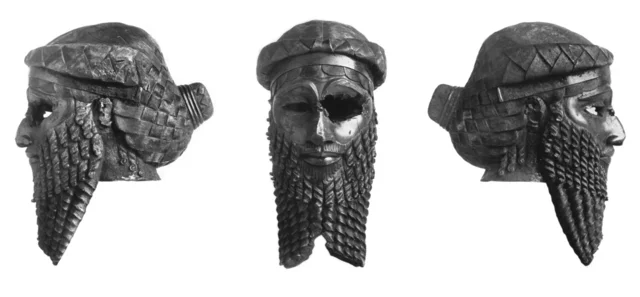 The Head of Akkadian Ruler Sargon the Great, is made out of Bronze and it measures at 12" in Height. It represents Divine Kingship and Power. The damage of his eye holds a symbolic meaning.
The Head of Akkadian Ruler Sargon the Great, is made out of Bronze and it measures at 12" in Height. It represents Divine Kingship and Power. The damage of his eye holds a symbolic meaning. -
Citation: Dr. Senta German, "Akkad, an introduction," in Smarthistory, June 8, 2018, accessed September 20, 2025, https://smarthistory.org/art-of-akkad-an-introduction/
-
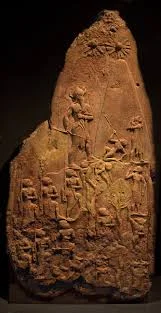 The Victory Stele of Naram Sin was carved out of Pink limestone, and it measures at about 6' 7" tall. It is a representation of Kingship because the god is wearing a horned helmet which was a symbol of godhood during that period.
The Victory Stele of Naram Sin was carved out of Pink limestone, and it measures at about 6' 7" tall. It is a representation of Kingship because the god is wearing a horned helmet which was a symbol of godhood during that period. -
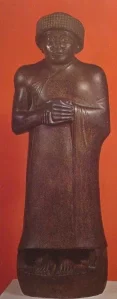 The Statue of Gudea was made out of a rock called diorite. It measures at about 21" in height. Gudea is a representation of worship and leadership.
The Statue of Gudea was made out of a rock called diorite. It measures at about 21" in height. Gudea is a representation of worship and leadership. -
Citation: Carolinarh, "The Neo Sumerian or Third Dynasty of UR", The artistic adventure of mankind, 18 July, 2023, https://arsartisticadventureofmankind.wordpress.com/2013/07/18/the-neo-sumerian-period-or-third-dynasty-of-ur/
-
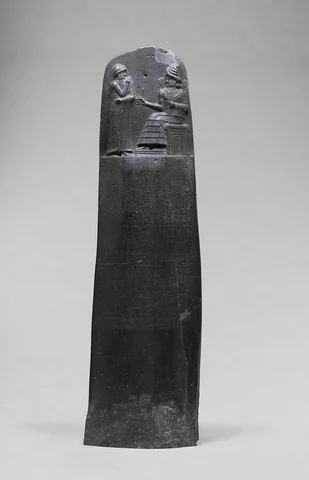 The Steele of Hammurabi is made out of Black basalt, and it measures at about 7'4" tall. It represents royalty because king Hammurabi is receiving his laws from king shamash.
The Steele of Hammurabi is made out of Black basalt, and it measures at about 7'4" tall. It represents royalty because king Hammurabi is receiving his laws from king shamash. -
Citation: Dr. Senta German, "Law Code Stele of King Hammurabi," in Smarthistory, August 8, 2015, accessed September 20, 2025, https://smarthistory.org/hammurabi-2/.
-
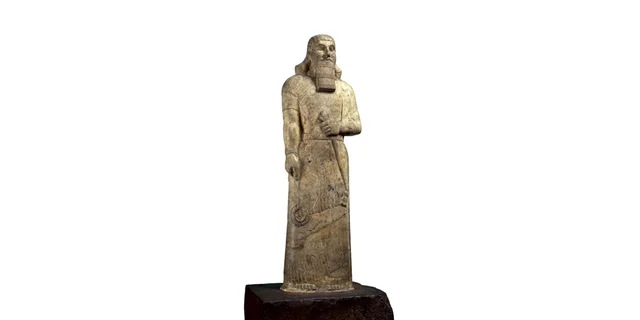 The Statue of Ashurnasirpal- Neo Assyrian, is a statue carved out of magnesite, a type of stone and it measures at about 3.7 feet tall. It represents power because his campaigns brought Assyria great wealth.
The Statue of Ashurnasirpal- Neo Assyrian, is a statue carved out of magnesite, a type of stone and it measures at about 3.7 feet tall. It represents power because his campaigns brought Assyria great wealth. -
Citation: The British Museum, "Assyrian sculpture," in Smarthistory, February 28, 2017, accessed September 20, 2025, https://smarthistory.org/assyrian-sculpture/.
-
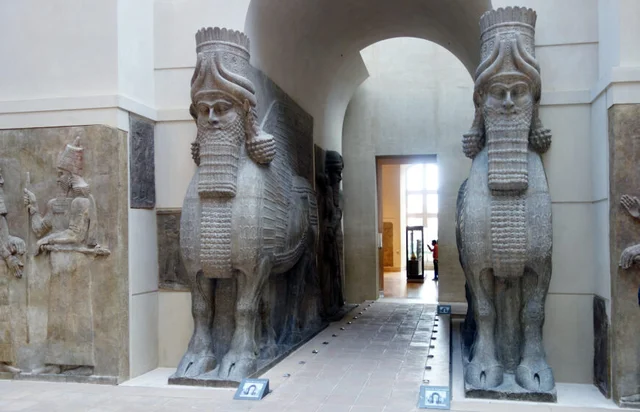 The Lamassu are huge human headed bull sculptures that measure up to 20 feet tall. They are made out of limestone, gypsum alabaster, or breccia. It is a representation of power and divinity.
The Lamassu are huge human headed bull sculptures that measure up to 20 feet tall. They are made out of limestone, gypsum alabaster, or breccia. It is a representation of power and divinity. -
Citation: Dr. Senta German, "Lamassu from the citadel of Sargon II," in Smarthistory, July 26, 2023, accessed September 20, 2025, https://smarthistory.org/lamassu-from-the-citadel-of-sargon-ii/.
-
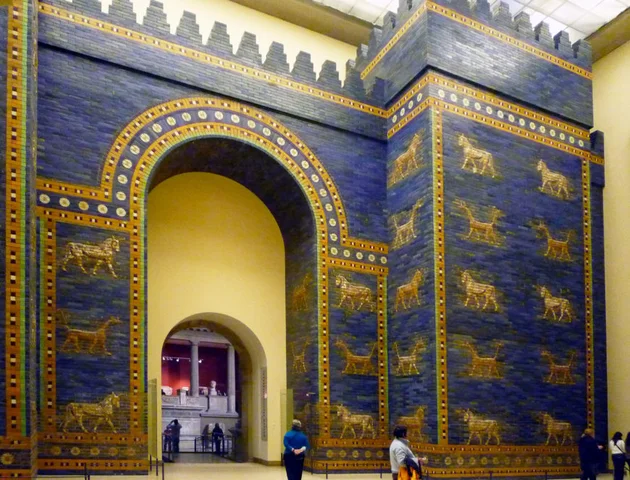 The Ishtar Gate was made out of Glazed mud brick, and served as a ceremonial entrance. It symbolizes power and wealth due to the materials they used to create this, for example, Lapis Lazuli.
The Ishtar Gate was made out of Glazed mud brick, and served as a ceremonial entrance. It symbolizes power and wealth due to the materials they used to create this, for example, Lapis Lazuli. -
Citation: Dr. Senta German, "The Ishtar Gate and Neo-Babylonian art and architecture," in Smarthistory, August 8, 2015, accessed September 20, 2025, https://smarthistory.org/neo-babylonian/.
-
 The Cyrus Cylinder is made out of baked clay, and it is about 8.6" x 3.9-3.1". It represents freedom because It was the first bill of human rights which helped abolish slavery.
The Cyrus Cylinder is made out of baked clay, and it is about 8.6" x 3.9-3.1". It represents freedom because It was the first bill of human rights which helped abolish slavery. -
Citation: The British Museum, "The Cyrus Cylinder and Ancient Persia," in Smarthistory, September 18, 2017, accessed September 20, 2025, https://smarthistory.org/cyrus-cylinder/.
-
Citation: Dr. Beth Harris and Dr. Steven Zucker, "Victory Stele of Naram-Sin," in Smarthistory, November 24, 2015, accessed September 20, 2025, https://smarthistory.org/victory-stele-of-naram-sin/.
Related works of art -
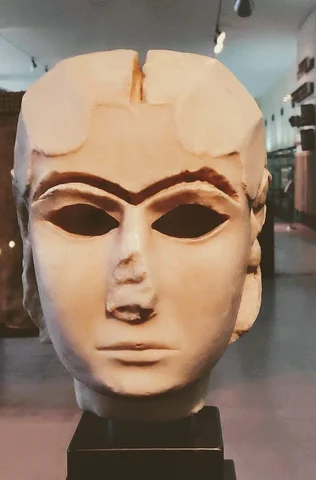 The Sumerian Mask of Warka was carved from Marble and it is 7" in height. The mask represents a deity, Ianna, making it a religious symbol. It is one of the earliest representations of the human face in Art.
The Sumerian Mask of Warka was carved from Marble and it is 7" in height. The mask represents a deity, Ianna, making it a religious symbol. It is one of the earliest representations of the human face in Art.